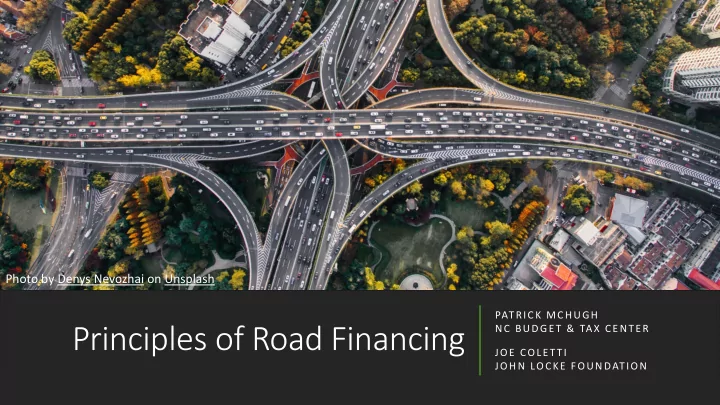

Photo by Denys Nevozhai on Unsplash PATRICK MCHUGH Principles of Road Financing NC BUDGET & TAX CENTER JOE COLETTI JOHN LOCKE FOUNDATION
Concerns Principles Agenda Conclusions
Concerns Shared: Transparency of funding — gas tax is not clearly understood as cost of wear on roads Shared: Level of funding — not enough money to meet all current demands Shared: Nature of funding — gas tax is regressive and could be more so with newer vehicles Shared: Sustainability of funding — shift of vehicle fleet makes gas tax less viable Shared: Urban/Rural divide — alternatives should not create new burdens for any one population Shared: Volume of roads — have we overbuilt and why? Shared: Role of public transit and other alternative modes of transportation Progressive: Health and economic impacts of carbon and other emissions Conservative: Matching demands to available funds, rather than raising taxes and fees to meet demand
Shared Principles Prioritize projects Shift from gas tax Capture value Subsidize need
Not enough money to build and maintain everything Court decision against the Map Act adds to already increasing costs Prioritize Projects Data-driven STIP process helps Consider transportation as part of a functioning labor market
Shift from Gas Tax Road funding is based on user fees (highway use tax, driver’s licenses, vehicle tags, and gas tax) Gas tax is the most direct user fee, an imperfect measure of miles driven and vehicle size Gas tax is easy to collect, each time someone refuels, and matches federal tax Changing technology limits future value of the gas tax and could make tax regressive Minimize initial revenue and distributional effects of transition from gas tax Burdens on people with least ability to pay should not increase Toll roads and toll lanes may be an option to consider
Capture Value Owners benefit from proximity to good roads Road/Interstate — connecting point-to-point Street/Intersection — commercial activity at that place Role for appropriately designed and implemented impact fees Explore role of public-private partnerships in capturing increased property value to maximize community benefits Harder to do with maintenance than with new construction
Increase consideration of need in subsidies for transportation Subsidize Need Incorporate value-capture into transit systems to make them more self-funding Align subsidies for housing and transportation
Areas of Contention Additional luxury tax on car ownership Most effective way to align affordable transportation and housing Best way to connect people to jobs, schools, and shopping Roles for tolling and public-private partnerships Definition of adequate revenue
There are more areas of agreement than disagreement • Extend good start in setting priorities for road funding so limited dollars go farther • Begin transition from gas tax to toll lanes and other mileage-based fees Conclusions • Consider ways to monetize the value transportation brings to property owners and businesses. This could become a bigger factor in setting priorities • Seek ways to subsidize need more effectively Applying the principles is more contentious than developing the principles
Recommend
More recommend